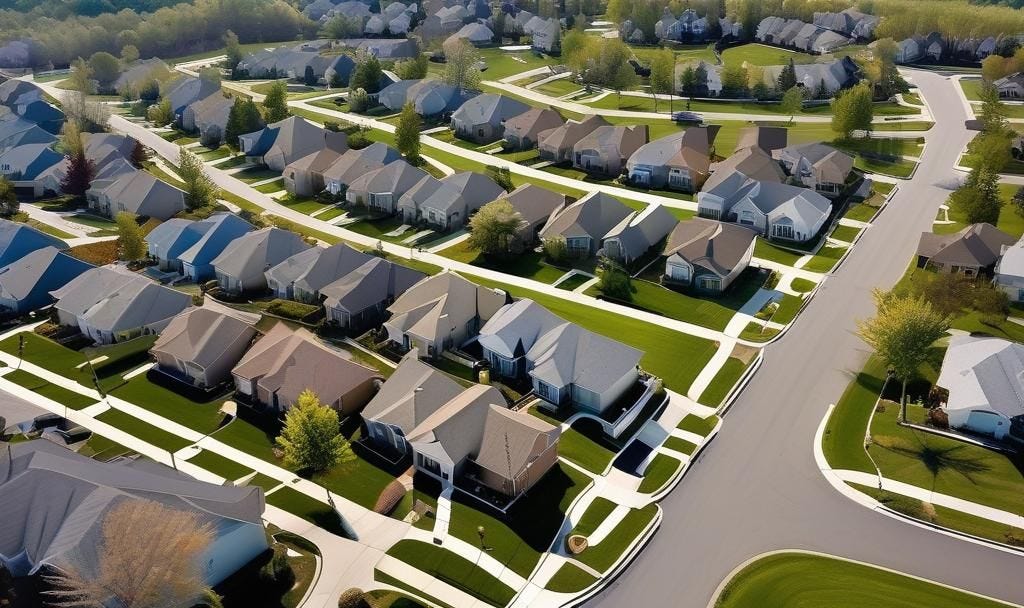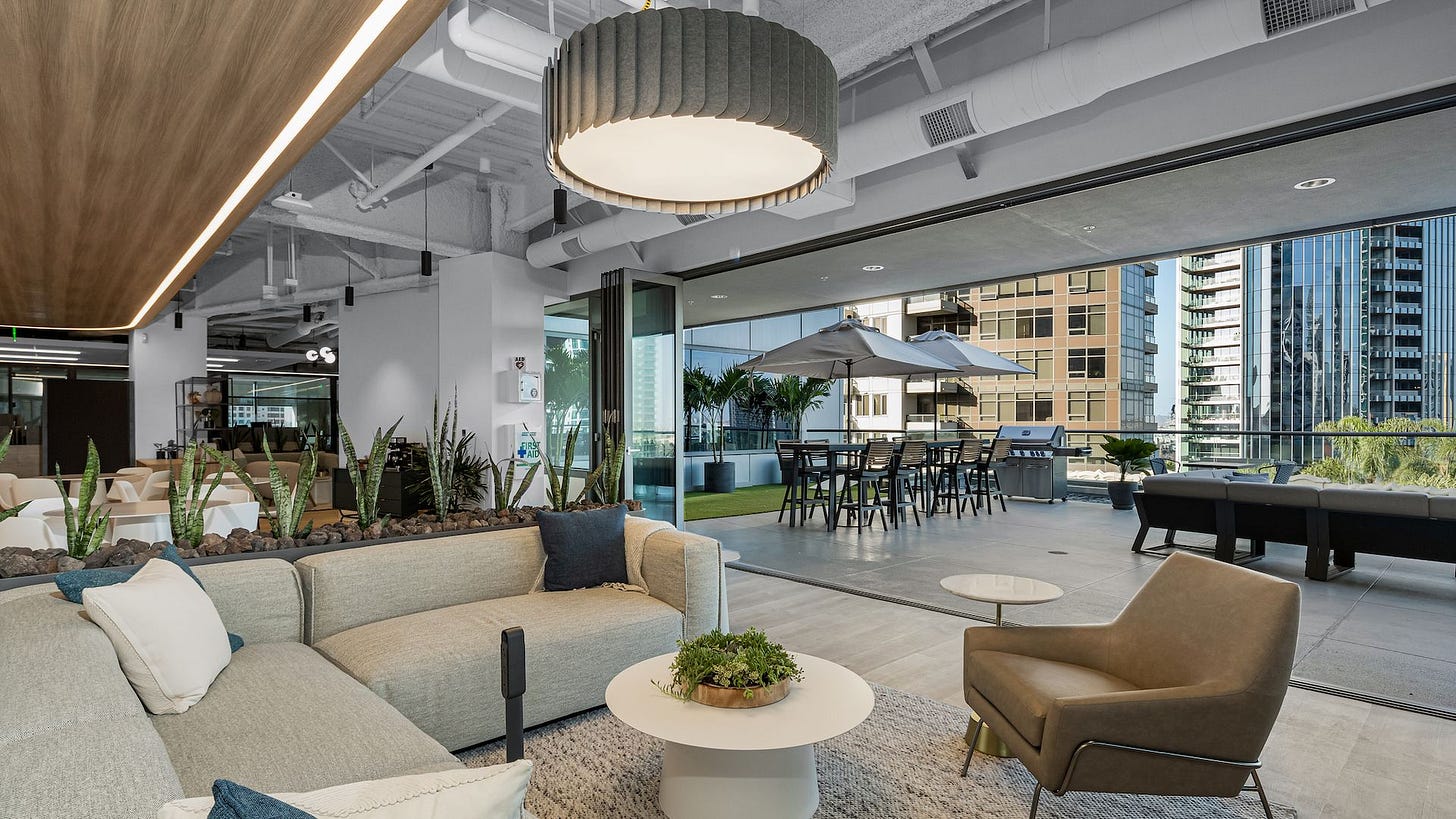The Suburban Workshop And The Urban Hotel
COVID turned the question where we live and where we work upside down. Now we work at home and "live" in business districts that used to be exclusively devoted to work.
Urbanists love downtowns, even if suburbanites often don’t. To an urbanist, a downtown is the walkable, historic, beating heart of a community. In the words of my longtime friend Rick Cole, who’s about to take office as a councilmember for the second time in Pasadena, downtown is “everybody’s second neighborhood”.
But the truth of the matter is that many downtowns as they were reinvented in the ‘70s and ‘80s are little more than office employment centers. And – as has become painfully obvious since COVID – that’s a problem. Because day-to-day office work has relocated to the suburbs – and not just to the suburbs, but to suburban homes.
In other words, we live in the era of the Suburban Workshop.
Suburban bedrooms are increasingly becoming America’s white-collar workshop.
A lot of people think this means the end of cities as we know them, as dense office districts decline because of the so-called “urban doom loop”.
But it’s not quite that simple. Because even as the era of the Suburban Workshop is emerging, so too is the era of the Urban Hotel. When people want to see each other in person – and there is considerable evidence that this will still be necessary – they will go to a downtown or an edge city.
So, together, the Suburban Workshop and the Urban Hotel represent a significant – and probably sustainable – reordering of how our cities function post-COVID.
The Suburban Workshop
The original idea of the suburb was to create separation between the city — in the 19th century, the dirty, smelly, polluted city — and the pastoral setting believed to be required for a healthy family life. Suburbs were an upper-class luxury until after World War II, when the mass production of housing and federal financing of mortgages made single-family suburban life possible for most people — at least for most white people.
Today, most Americans live in the suburbs. And for most families, locational decisions about suburban life have traditionally revolved around the geometry of commuting.
But for office workers, the ability to work at home even part time blows all those calculations to pieces. All of a sudden, you don’t have to go anywhere very far from home, at least on some days, in order to make a living. Just my ancestors made textiles on home looms in Scotland hundreds of years ago, today office workers craft reports and documents in their spare bedrooms. They have turned their houses house into a Suburban Workshop, where most of the work of a company — work that does not require face-to-face contact — actually takes place.
But that doesn’t mean the suburbs will remain the same as they’ve always been. As the residential suburb turns into the Suburban Workshop, the suburbs will change.
For one thing, more people will demand more amenities closer to home. Households without children at home — and that’s most households, even in the suburbs — go out to bars, restaurants and other events more often.
When suburbanites work in big job centers, they have a variety of options for going out after work near their office. When they work at home — or at their local co-working center — they’re not likely to be content with their local Applebee’s.
And second, the millennials will finally show up in the suburbs.
A big question over the past few years is whether millennials will leave the city for the suburbs once they start getting married and having children. It’s a question that urbanists fear the answer to and urban critics gloat over.
And the answer is: Of course they’ll move to the suburbs.
In large part, they have no choice — there are far more residences located in suburbs than in cities in America. And in part, millennials will go to the suburbs for the same reasons that previous generations have gone: schools, space and a little peace and quiet.
Millenials and Gen Zers will show up in the suburbs whether they like it or not. They don’t have very many other options.
But they’re going to bring their urban sensibility with them. They’re going to want places and spaces that are charming and walkable and have a lot of amenities — places where they can reconstruct city life to the greatest extent possible. Think Sugar Land Town Square or The Woodlands Town Center. These are the kind of suburbs that will be most in demand — and that developers will fall all over themselves to create. The Suburban Workshop – the transformation of suburbs into workplaces – will make suburbs more interesting to live in.
The Urban Hotel
For the past few months, I’ve been looking out the window of my condo in Downtown San Diego at a very unusual construction project that I couldn’t figure out: an office seemed to be getting tricked out as a informal social setting complete with lounges and even a patio – just across from me – with comfy sofas. It was clearly not going to be an office. Maybe a social club.
But as Axios San Diego recently revealed, it is an office. Specifically, it’s the revamped (and smaller) North American headquarters for the global cybersecurity firm ESET. I won’t comment on the irony of a cybersecurity firm opening up its office so much that it’s easily visible to neighbors like me. But suffice it to say that the new ESET office is specifically designed to accommodate hybrid workers who mostly do their work at home but come to the office now and then to interact with their colleagues.
The new ESET North American headquarters in Downtown San Diego. I live in the condo building you can see across the street.
Welcome to The Urban Hotel.
A lot of ideas are kicking around for how to transform downtowns – and not just traditional downtowns, but “edge cities” like Century City in Los Angeles, The Galleria in Houston, and Tysons Corners in Virginia, which were gradually transforming themselves before the pandemic from sterile suburban office centers to 21st Century downtowns?
These ideas include housing (and associated neighborhood retail), entertainment, culture. For older downtowns, cashing in on a sense of authenticity in the built environment. In both older downtowns and edge cities, cashing in on the walkability that some people seem to want these days.
Some of these strategies may work and some may not. But, like the new ESET headquarters, they all revolve around the same underlying: face-to-face interaction. When people want to see each other in person, they will go to a downtown or an edge city.
In other words, even as the pandemic has solidified the role of the Suburban Workshop, the post-pandemic era will also become the era of the “Urban Hotel”.
In using this term, I don’t mean that downtowns and edge cities will literally consist of nothing but hotels (though hotels play an important role in this transition).
What I mean is that — even more than in the past — these locations will exist primarily to facilitate face-to-face contact that simply cannot be replicated in any other way. There’s so much that happens in an in-person meeting that Zoom can’t provide: body language cues get picked up, human connections are made, trust gets built.
The Urban Hotel provides the infrastructure for face-to-face meetings. Hotel meeting rooms, restaurants, coffee shops, food halls, convention centers, conference rooms in office buildings and co-working spaces — all of these provide the venues for face-to-face contact. And, of course, face-to-face contact isn’t possible — or at least it’s inconvenient — if people aren’t already located in close proximity to one another, either by officing in the area or staying in one of the hotels.
So, yes, in some ways the post-COVID world means suburbs win and cities lose. But it’s probably more accurate to say that the role of suburbs and cities will change. Cities have always been flexible and resilient, able to accommodate – sooner or later – significant changes in the way people live and work. The Urban Hotel will be the latest manifestation of that flexibility and resilience. And the Suburban Workshop will present a challenge that suburban locations have never faced before. Having been built with the idea that they would be petrified forests of human activity, they too must transform themselves to accommodate changes in the the way people live and work.







I have a quibble regarding this statement: " Suburbs were an upper-class luxury until after World War II, when the mass production of housing and federal financing of mortgages made single-family suburban life possible for most people — at least for most white people."
This ignores the much earlier expansion of "trolley car" or "street car" neighborhoods. I live in a working-class bungalow build in 1926 in the North Berkeley/Albany area. My house is two-bedroom, one-bathroom, 1,100 square-foot stucco box (after a laundry room addition). The street cars used to run across the Bay Bridge, allowing for the first pre-WWII wave of suburbanization.
I used to think that photographers needed to know how to use manual settings on a camera, but the next generation probably doesn't. So while I hear the "Zoom can't give you body language cues and connections" argument often from boomers, I wonder if millennials and gen Z zoomers, would even recognize body language if their entire experience is on-screen. Human connection may not matter to a generation that only connects by manipulating glass.